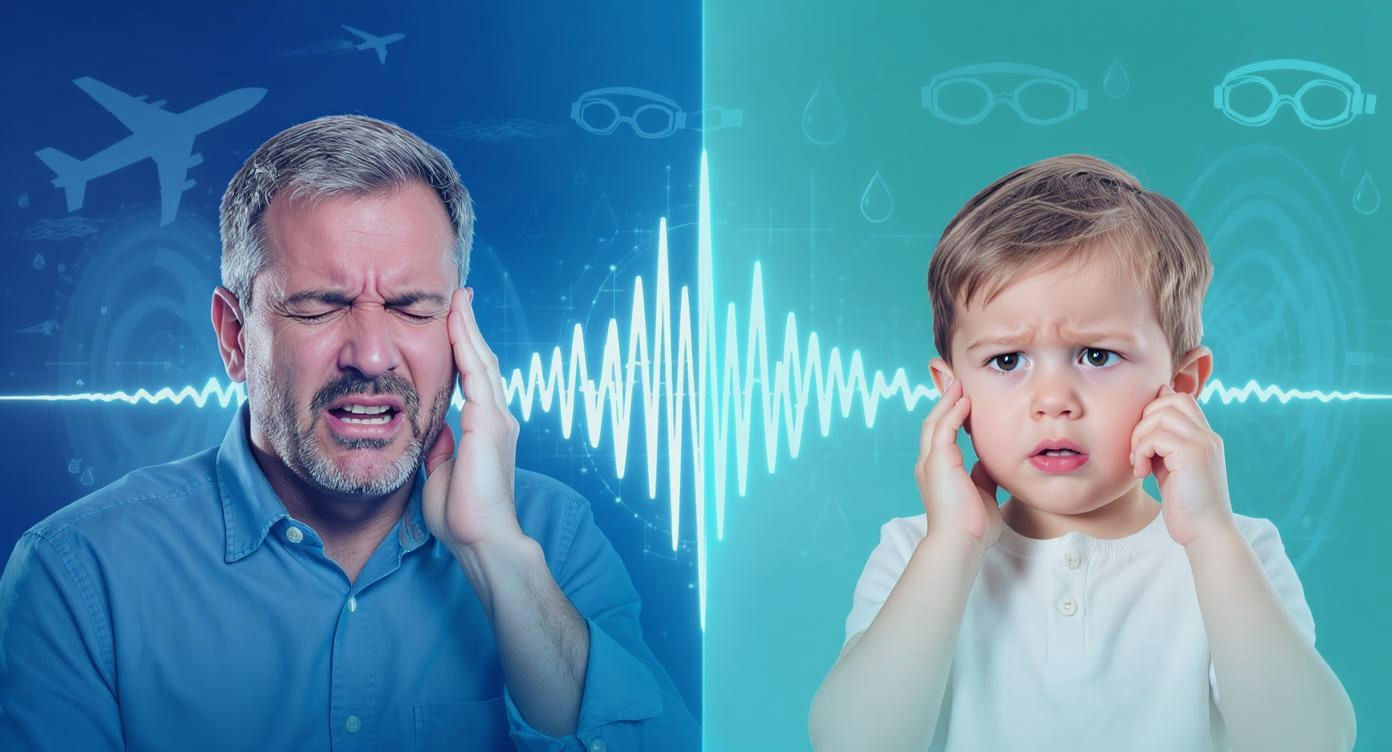The Complete Guide to Ear Infections: Adult vs. Child Treatment Approaches
The Complete Guide to Ear Infections: Adult vs. Child Treatment Approaches
Executive Summary
This comprehensive guide explains the key differences between ear infections in children and adults, including why they occur, how they’re diagnosed, and the latest treatment approaches. We explore prevention strategies for high-risk groups like swimmers and travelers, while providing practical home remedies and clear guidelines on when to seek medical care at Care& Family Health.
Table of Contents
- Introduction
- Understanding Ear Infections: The Basics
- Children vs. Adults: Key Differences
- Symptoms Across Age Groups
- Diagnostic Approaches
- Treatment Approaches
- Prevention for Swimmers
- Prevention for Frequent Flyers
- When to Seek Medical Care
- Care& Approach to Ear Infections
- Home Remedies That Work
- Special Populations and Considerations
- The Future of Ear Infection Treatment
- FAQ: Common Questions
- Conclusion
Introduction
That persistent ear pain, the feeling of pressure, muffled hearing—ear infections can disrupt daily life for both children and adults. While many think of ear infections as primarily a childhood concern, adults in Toronto and beyond frequently struggle with these uncomfortable and sometimes debilitating infections too.
At Care& Family Health, we see patients across all age groups seeking relief from ear infections, especially during swimming season and peak travel periods when changing air pressure and water exposure increase risk factors. Whether you’re a parent concerned about your child’s repeated ear infections or an adult dealing with your own ear discomfort, understanding the difference between childhood and adult ear infections is crucial for proper prevention and treatment.
This comprehensive guide explores how ear infections develop, why treatment approaches differ between children and adults, and practical prevention strategies for those particularly susceptible—like swimmers and frequent flyers. We’ll help you recognize when to seek medical attention and provide evidence-based strategies to reduce your risk of recurring infections.
Understanding Ear Infections: The Basics
What Exactly Is an Ear Infection?
An ear infection (otitis media) occurs when fluid builds up in the middle ear behind the eardrum and becomes infected. This common condition affects the air-filled space containing the tiny vibrating bones of the ear, which can become inflamed and painful when infected.
There are three main types of ear infections:
- Middle ear infections (otitis media) – Infection of the air-filled space behind the eardrum
- Outer ear infections (otitis externa) – Often called “swimmer’s ear,” affecting the ear canal
- Inner ear infections (labyrinthitis) – Less common but can cause more severe symptoms including vertigo
Ear Anatomy: Why Infections Occur
Understanding ear anatomy helps explain why infections develop differently in children versus adults:
The eustachian tubes connect the middle ear to the back of the throat, helping to:
- Regulate air pressure in the ear
- Refresh air in the ear
- Drain normal secretions
In children, these tubes are:
- Shorter
- More horizontal
- Narrower
This anatomical difference makes children’s eustachian tubes less effective at draining fluid and more susceptible to becoming blocked, creating an ideal environment for bacteria to grow.
Children vs. Adults: Key Differences in Ear Infections
Why Children Are More Susceptible
Children in Toronto and across Canada experience ear infections approximately 5-6 times more frequently than adults, with statistics showing:
- By age three, more than 80% of children will have experienced at least one ear infection
- Nearly 40% will have had three or more episodes
This higher frequency stems from several factors:
- Developing Immune Systems: Children’s immune responses are still maturing, making them less effective at fighting off infections
- Anatomical Differences: Their shorter, more horizontal eustachian tubes don’t drain as efficiently
- Adenoid Tissue: Children have larger adenoid tissue, which can block eustachian tubes when inflamed
- Group Settings: Exposure to more respiratory infections in daycares and schools
How Adult Ear Infections Differ
Adult ear infections occur less frequently but tend to be:
- More painful
- Sometimes linked to underlying health conditions
- Potentially indicative of other health issues
- More likely to be chronic rather than acute
Common triggers for adult ear infections include:
- Upper respiratory infections
- Allergies
- Smoking
- Immune system disorders
- Skin conditions like eczema (for outer ear infections)
Symptoms: Recognizing Ear Infections Across Age Groups
In Children
Children often cannot clearly articulate their symptoms, making it important for parents to recognize these signs:
- Tugging or pulling at the ear
- Excessive crying and irritability, especially when lying down
- Difficulty sleeping
- Fever (particularly in younger children)
- Fluid draining from the ear
- Poor feeding or difficulty maintaining suction while nursing
- Balance problems
- Hearing difficulties/not responding to quiet sounds
In Adults
Adult symptoms tend to be more specific:
- Ear pain (often sharp and sudden)
- Muffled hearing or hearing loss
- Sensation of fullness in the ear
- Drainage from the ear (purulent fluid)
- Tinnitus (ringing in the ear)
- Dizziness or vertigo in some cases
- Malaise and fatigue
- Fever (less common than in children)
Care& App Feature
Track ear infection symptoms using the Care& Health Metrics feature. Document symptoms, record temperature readings, and share this information directly with your healthcare provider through our secure platform for more effective appointments.
Diagnostic Approaches
How Medical Clinics Diagnose Ear Infections
At a medical clinic in Toronto like Care&, Nurse Practitioners and healthcare providers use several methods to diagnose ear infections accurately:
-
Physical Examination: Using an otoscope to look at the eardrum for:
- Redness
- Bulging or retraction
- Fluid behind the eardrum
- Reduced eardrum movement when air is puffed against it
- Patient History: Reviewing symptoms, recent illnesses, and patterns of previous infections
- Tympanometry: A test that measures eardrum movement, helping to detect fluid in the middle ear
- Acoustic Reflectometry: Measures how sound reflects off the eardrum to detect fluid
When Additional Testing Is Needed
For recurrent or complicated infections, healthcare providers might recommend:
- Hearing tests to check for hearing loss
- Tympanocentesis (rarely used) to collect fluid for cultural analysis
- Imaging studies like CT scans for chronic cases to look for structural abnormalities
Experiencing ear pain or suspect an infection?
Our Nurse Practitioners at Care& can provide a thorough ear examination with same or next-day appointments.
Treatment Approaches: Why Age Matters
Children’s Treatment Protocols
The approach to treating children’s ear infections has evolved significantly in recent years:
Wait-and-See Approach
For many children between 6 months and 2 years with mild symptoms, Canadian medical guidelines recommend:
- 48-72 hours of observation with pain management
- This approach helps reduce unnecessary antibiotic use
- Parents should monitor for worsening symptoms
When Antibiotics Are Appropriate
Antibiotics are typically prescribed for:
- Children under 6 months
- Children with severe symptoms
- Infections in both ears for children under 2
- When symptoms don’t improve after 48-72 hours of observation
Common antibiotics include amoxicillin as a first-line treatment, with alternatives for penicillin-allergic patients.
Pain Management
Pain relief is essential and may include:
- Over-the-counter pain relievers (acetaminophen or ibuprofen)
- Warm compresses held against the ear
- Prescription ear drops for pain (in some cases)
Adult Treatment Strategies
Adults typically receive a more targeted approach:
Antibiotic Considerations
- Antibiotics may be prescribed immediately for severe symptoms
- The wait-and-see approach is often used for mild cases
- Targeted antibiotics based on the likely causative organism
Managing Underlying Conditions
Adult treatment often includes addressing contributing factors:
- Treating allergies
- Managing sinus issues
- Addressing immune system concerns
- Smoking cessation support
Pain and Symptom Management
- Stronger pain medication may be prescribed if needed
- Decongestants to help open the eustachian tubes
- Anti-inflammatory medications
When Surgery Might Be Necessary
For recurrent infections, surgical interventions might be considered:
For Children:
- Tympanostomy tubes (ear tubes) to help drain fluid and equalize pressure
- Adenoidectomy in some cases where enlarged adenoids contribute to recurrent infections
For Adults:
- Myringotomy (small incision in the eardrum) to relieve pressure and drain fluid
- Tympanostomy tubes are less common but may be used for chronic cases
Prevention Strategies for Swimmers
Swimming is a popular activity in Toronto’s many pools and lake areas, but it can increase the risk of outer ear infections (swimmer’s ear). Here’s how to protect yourself:
Before Swimming
1. Consider protective gear:
- Use well-fitted silicone or custom ear plugs designed for swimming
- Swim caps that cover the ears can provide an additional barrier
2. Check water quality:
- Be cautious about swimming in lakes or ponds after heavy rainfall
- Pay attention to public health advisories about water quality
During Swimming
1. Keep water out:
- Avoid diving or submerging completely when possible
- Use proper technique to minimize water entry into ears
2. Be aware of water temperature:
- Very cold water can sometimes cause ear pain that mimics infection
After Swimming
1. Proper ear drying technique:
- Tilt your head to each side to let water drain naturally
- Gently dry the outer ear with a soft towel
- Never insert cotton swabs or other objects into the ear canal
2. Use a preventive drying solution:
- Equal parts white vinegar and rubbing alcohol (1-2 drops in each ear)
- Commercial ear-drying products available at pharmacies
- These solutions help restore proper pH and dry remaining moisture
3. Hair dryer method:
- Set a hair dryer on the lowest heat and fan setting
- Hold it at least 30 cm (12 inches) from your ear
- The gentle airflow helps evaporate trapped water
For Competitive Swimmers
Frequent swimmers should consider these additional measures:
- Customized swim earplugs from an audiologist
- Routine preventive ear drops before and after swimming
- Regular check-ups with a healthcare provider during peak swimming season
- Taking breaks from swimming if early symptoms appear
Care& App Feature
Swimmers can use the Care& Knowledge Base to access evidence-based information about ear infection prevention. Have questions about swimmer’s ear? Use our Secure Admin Chat to message our clinical team directly.
Prevention Strategies for Frequent Flyers
Air travel can trigger ear infections or exacerbate existing ones due to pressure changes. Here’s how Toronto’s frequent travelers can protect themselves:
Before Flying
1. Manage existing conditions:
- Address allergies or sinus problems before flying
- Consider using a decongestant 30 minutes prior to takeoff if you have a cold
- Consult with your healthcare provider if you have an active ear infection—flying may be contraindicated
2. Stay hydrated:
- Drink plenty of water before and during the flight
- Avoid alcohol and caffeine which can contribute to dehydration
During the Flight
1. Equalize ear pressure regularly:
- Swallow frequently, especially during takeoff and landing
- Yawn or chew gum to activate the muscles that open eustachian tubes
- Try the Valsalva maneuver: pinch your nostrils closed, close your mouth, and gently attempt to blow air through your nose
2. Stay awake during descent:
- The most problematic pressure changes occur during descent
- Ensure you’re actively equalizing pressure during this time
3. Use pressure-regulating earplugs:
- Special earplugs designed for air travel can help regulate pressure changes
- These are available at most pharmacies and airport shops
For Children During Flights
Children are particularly vulnerable to ear pain during flights:
- Feed infants during takeoff and landing – the swallowing helps equalize pressure
- Have older children drink from a cup or water bottle
- Teach them to “pop” their ears by yawning or swallowing
- Bring pain relievers just in case ear pain develops
When to Seek Medical Care
Warning Signs That Require Prompt Attention
While many ear infections resolve with home care or minimal treatment, certain symptoms warrant a medical appointment:
For Children:
- Fever of 39°C (102.2°F) or higher
- Severe ear pain
- Irritability or lethargy
- Discharge from the ear
- Symptoms that worsen or don’t improve after 48-72 hours
- Hearing difficulties that persist after infection clears
- Repeated ear infections (more than 3 in 6 months or 4 in a year)
For Adults:
- Severe pain that interferes with sleep or daily activities
- Symptoms lasting more than 3 days
- Discharge from the ear
- Hearing loss
- Dizziness or balance problems
- High fever or severe headache
- Swelling behind the ear or around the ear lobe
Long-term Considerations
Both children and adults should consider follow-up care for:
- Recurring infections
- Persistent hearing problems
- Development delays in children (speech or language)
- Chronic ear fluid that doesn’t clear up
Need medical advice for an ear infection?
Care& offers same or next-day appointments with experienced healthcare providers.
Care& Approach to Ear Infections
At Care& Family Health, our Nurse Practitioners take a comprehensive approach to diagnosing and treating ear infections:
- Thorough examination using modern diagnostic tools
- Patient-centered treatment plans that consider both immediate relief and prevention of recurrence
- Unrushed appointments to fully address questions and concerns
- Continuity of care for monitoring treatment effectiveness and managing chronic cases
For patients with recurrent ear infections, we offer:
- Comprehensive assessment to identify underlying causes
- Preventive strategies tailored to individual risk factors
- Coordination with specialists when necessary
- Ongoing support through our mobile app for monitoring symptoms and accessing care
Our Convenient Locations
Visit our medical clinics in Lawrence Park or Yorkville for expert care.
Mobile App Support
Access your health records, message your provider, and book appointments through our app.
Home Remedies That Actually Work
While medical treatment is often necessary, these evidence-supported home remedies can help manage ear infection symptoms:
Pain Relief
-
Warm compress:
- Apply a warm (not hot) washcloth to the affected ear
- Hold in place for 10-15 minutes to help reduce pain
-
Over-the-counter pain relievers:
- Acetaminophen or ibuprofen can reduce pain and fever
- Always follow appropriate dosing guidelines, especially for children
-
Sleeping position:
- Elevating the head while sleeping can help fluid drain
- For children, placing a small towel under the mattress creates a gentle incline
Supporting Recovery
- Rest: Adequate sleep helps support immune function
- Hydration: Staying well-hydrated helps thin mucus and supports overall healing
- Avoid irritants: Keep tobacco smoke and other pollutants away from the affected person
Remedies to Avoid
Some popular remedies lack evidence or may cause harm:
- Ear candling: No scientific evidence supports its use and it may cause injury
- Essential oils in the ear canal: Can cause irritation and allergic reactions
- Hydrogen peroxide: May be irritating to an already inflamed ear canal
- Cotton swabs: Can push wax deeper and damage the ear canal or eardrum
Special Populations and Considerations
Immunocompromised Individuals
People with weakened immune systems require special attention:
- May need earlier intervention with antibiotics
- Often experience more severe symptoms
- May benefit from prophylactic strategies during high-risk seasons
- Should be monitored more closely for complications
Diabetic Patients
Patients with diabetes face additional risks:
- Higher susceptibility to outer ear infections
- Potentially more severe infections that spread more quickly
- May require more aggressive treatment approaches
- Need careful blood glucose management during infection
Older Adults
Seniors may experience:
- More subtle symptoms that can be mistaken for other conditions
- Increased risk of hearing loss
- Potential balance issues that increase fall risk
- Need for careful medication selection due to potential interactions
The Future of Ear Infection Treatment
Medical approaches to ear infections continue to evolve:
-
Antibiotic stewardship:
- More selective use of antibiotics
- Better targeting of specific pathogens
- Development of new antibiotic delivery methods
-
Preventive vaccines:
- Pneumococcal and influenza vaccines already reduce some ear infections
- Research into vaccines targeting other common ear infection pathogens
-
Innovative treatments:
- Research on probiotics for preventing recurrent infections
- Development of better diagnostic tools for rapid, accurate diagnosis
- New approaches to managing eustachian tube dysfunction
Stay Updated with Care&
The Care& Knowledge Base in our app is regularly updated with the latest evidence-based information on ear infection prevention and treatment. Our healthcare providers stay current on emerging research to ensure you receive the most effective care.
FAQ: Common Questions About Ear Infections
Q: Can ear infections clear up on their own without antibiotics?
A: Yes, many ear infections, especially in adults and older children, can resolve without antibiotics. The Canadian Paediatric Society and American Academy of Pediatrics both support a “wait-and-see” approach for mild to moderate ear infections in healthy children over 6 months. During this time, pain management is essential while monitoring for worsening symptoms that might indicate antibiotic treatment is needed.
Q: How can I tell the difference between an ear infection and just ear wax?
A: While both can cause discomfort, ear infections typically cause pain, possibly fever, and sometimes fluid drainage that may be yellow, cloudy, or bloody. Ear wax, though sometimes uncomfortable, generally doesn’t cause pain or fever. Ear wax is typically yellow-brown and appears in the outer ear canal. If you’re unsure, a healthcare provider can make an accurate diagnosis by examining your ear with an otoscope.
Q: Are recurrent ear infections in adults something to worry about?
A: Yes, recurrent ear infections in adults warrant medical attention. Unlike children who often outgrow ear infections as their anatomy develops, adults with repeated infections may have an underlying issue such as immune dysfunction, anatomical abnormalities, or chronic conditions that need addressing. At Care&, our Nurse Practitioners can develop a comprehensive plan to identify and address the root causes of recurring infections.
Q: How long should I wait before seeking medical care for an ear infection?
A: For adults with mild symptoms, it’s reasonable to try home management for 2-3 days. However, seek medical care promptly if you experience severe pain, fever over 39°C (102.2°F), dizziness, or hearing loss. For children under 6 months, any suspected ear infection requires immediate medical attention. Children between 6 months and 2 years should be seen if symptoms don’t improve within 48-72 hours or worsen at any point.
Q: I’ve heard antibiotics aren’t always necessary for ear infections. How will my healthcare provider decide if I need them?
A: Healthcare providers at medical clinics like Care& make this determination based on several factors: the patient’s age, severity of symptoms, whether one or both ears are affected, medical history, and risk factors. For example, children under 6 months, patients with severe symptoms, or those with certain medical conditions typically receive antibiotics immediately. For others, providers might prescribe antibiotics but recommend waiting 48 hours before filling the prescription to see if symptoms improve on their own.
Have more questions about ear infections?
Our Nurse Practitioners are ready to help with personalized advice.
Conclusion: Taking Control of Ear Health
Ear infections, while common, don’t have to repeatedly disrupt your life or your child’s. Understanding the differences between adult and pediatric ear infections empowers you to take proactive steps toward prevention and seek appropriate treatment when necessary.
For Toronto’s active population—from swimmers enjoying the city’s pools and beaches to frequent business travelers—implementing targeted prevention strategies can significantly reduce infection risk. Remember that anatomical differences, immune function, and environmental factors all play roles in ear infection susceptibility, making personalized approaches to prevention most effective.
If you’re experiencing ear pain or other symptoms that concern you, don’t hesitate to schedule a medical appointment. At Care& Family Health, our Nurse Practitioners offer comprehensive ear examinations with same or next-day availability at our Lawrence Park and Yorkville medical clinics. With unrushed appointments and continuity of care, we can help you develop effective strategies for both treating current infections and preventing future ones.
Your ear health affects everything from communication to balance—it deserves thoughtful attention and care. By implementing the prevention strategies outlined in this guide and seeking timely treatment when needed, you can maintain healthy ears year-round, regardless of your age or lifestyle.
Less Wait Time, More Face Time
Experience healthcare that fits your schedule with Care& Family Health.
Visit www.careand.ca to register
Disclaimer: This article is for informational purposes only and does not constitute medical advice. Always consult with a qualified healthcare provider for personal medical guidance. The information provided is general in nature and may not apply to individual circumstances.







